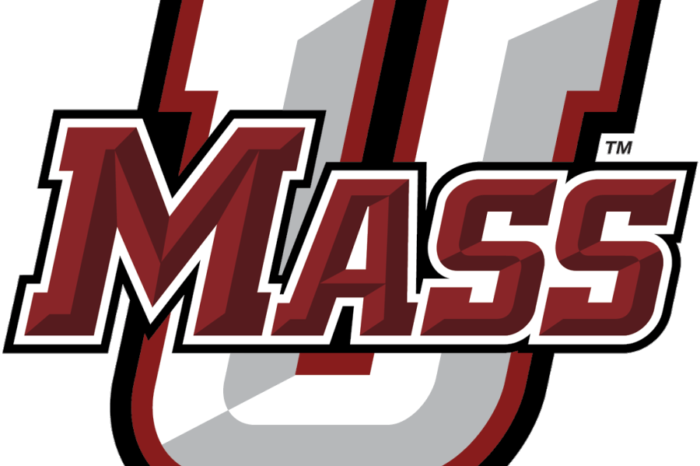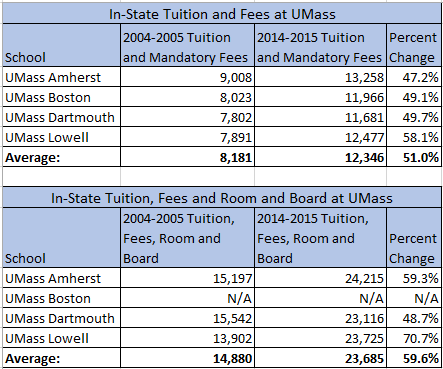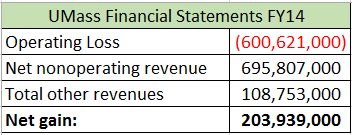UMass Tuition Hikes: Why Not Cut Costs?
And shouldn’t in-state students be the top priority?
WRKO’s Boston.com Morning Show Host Kim Carrigan interviewed Pioneer’s Mary Connaughton about the findings in this post. Listen here.
Just two days ago, the Boston Globe highlighted an important issue regarding UMass tuition and fee increases for the coming academic year. While making a fair point that public investment is needed to improve the quality of education at the University of Massachusetts, Pioneer offers a different take: rather than concentrating on obtaining greater funding, UMass should focus on cutting costs internally and on putting the focus back on its in-state students.
Tuition and Fee Hikes
In early August, MA Senate President Stanley Rosenberg wrote a letter to UMass President Marty Meehan asking him to reconsider the university’s decision to raise tuition and fees by 5 percent for the 2015-2016 school year. In the letter, Rosenberg references conversations he has had with students that are already struggling to pay their tuition bills and believes that the additional $900 a year could put college out of reach for some students. UMass Amherst is within Rosenberg’s district, making this issue hit close to home.
In his letter, Rosenberg makes it clear that funding for the university will be a top priority of his and UMass has announced its hope that he will win the university full funding. In August, the Legislature already overrode Governor Baker’s veto and restored $5.2 million in additional funding for UMass. While trying to make tuition more affordable is an admirable goal, both Meehan and Rosenberg are only pursuing the narrow solution of increasing state funding. Stabilizing tuition prices does not inherently mean the government needs to provide more money; instead, the focus should first be on finding cost efficiencies to make up the difference.
The skyrocketing cost of tuition has been a hot topic in the media, demonstrated by Hillary Clinton recently revealing her plan that would ensure loan-free tuition for U.S. students. The buzz has likely been prompted by the fact that outstanding student debt has reached $1.2 trillion. UMass is no exception to this trend, as in-state tuition prices have increased an average of 51 percent from 2004-2014 across the four main campuses. Average in-state tuition plus room and board costs have increased substantially as well, by 59.6 percent. Last year, it cost a Massachusetts resident $24,215 to attend UMass Amherst full-time and live on campus.
(Source: UMass Fact Sheets from 2004-2005 and 2014-2015)
Furthermore, UMass’ own 2015 Report on Annual Indicators demonstrates how tuition has increased as a percentage of the median family income in Massachusetts, from 12 percent in 2004 to 15 percent in 2014.
The increasing cost of tuition has significantly impacted UMass student loan and debt numbers. UMass recognizes this for its Amherst campus in the same report:
An increase of nearly 20 percent in average student debt in just five years is a matter that UMass should be taking seriously. The University should be taking steps to cut costs and provide a quality education at a price that doesn’t require students to take on increasingly greater debt.
The issue of rising tuition becomes of even greater importance after considering UMass’ financial statements. In 2014, after accounting for all revenues and expenses, UMass retained a profit of over $200 million.
How is it in the best interest of the students to increase tuition by 5 percent next year when UMass made a profit the previous year? Students attending these public universities deserve an affordable education where they can be sure that their money is being spent wisely and for the students’ benefit.
Prioritizing Students from the Commonwealth
Pioneer recently published a blog looking into why tuition has been increasing at UMass, which analyzed three main factors: administrative costs, increased project spending, and changes in government funding. We found that there was a $20 million dollar increase in spending on administrative assistant salaries at UMass from 2004-2013. Furthermore, construction expenditures remained low from 2007-2009, but then spiked when UMass spent between $6 million and $18 million annually on construction projects from 2010-2013. With these factors contributing to the 51 percent increase in tuition, we must consider: is this serving the students’ best interests?
Looking at reports published by UMass, there are a number of indicators that suggest increased spending in these areas has not benefitted the university’s students, specifically those residing in the Commonwealth.
For instance, according to UMass Fact Sheets from 2004-2005 and 2014-2015, the percentage of students that are residents of Massachusetts has fallen from 87.1 percent of undergraduates to 82 percent over the 10-year period. In its 2015 Report on Annual Indicators, UMass explains “the percent has declined in recent years as the campus strives to increase enrollment of out-of-state and international students.” While UMass claims that out-of-state and international students are being targeted for “geographic diversity”, what is actually attractive about these students is that they pay out-of-state tuition. UMass targets these students for their money. But even with more students coming to the university paying full-price tuition, UMass is still raising tuition for in-state students that may not have the ability to meet the rising cost. While some slots should be reserved for out-of-state and international students, as a public university, UMass should first and foremost provide an affordable education to students in the Commonwealth.
Furthermore, UMass has experienced a decrease in full-time students in recent years. From 2004-2014, full-time undergraduate students have decreased from 88.4 percent to 82 percent. This is consistent with a national trend of students opting to attend school part-time because they cannot afford the price tag of full-time attendance.
On top of this, UMass is meeting less of its in-state students’ financial need. In only five years, UMass went from meeting 91 percent to only 82 percent in 2013-2014.
UMass has a responsibility to invest in the education of students in the Commonwealth. The University of Massachusetts mission statement is “to provide an affordable and accessible education of high quality and to conduct programs of research and public service that advance knowledge and improve the lives of the people of the Commonwealth, the nation and the world.” UMass needs to prioritize increasing affordability and accessibility for its in-state students. As a significant portion of its funds come from the state, job #1 of this public university is to provide an education to students in Massachusetts that is within their budget.
Conclusion
UMass needs to stop looking externally- to students, to the Senate President, to state government- for money to fund ever-increasing administrative expenditures. Instead, UMass needs to look inward and review which expenses are actually essential and beneficial to its students and identify how to reduce costs internally. The university can start with the recent rises in administrative and construction expenses, which have not translated into benefits for its students, especially those residing in Massachusetts. Receiving over $500 million in state funding, UMass needs to ensure that it is meeting the needs of its in-state students first and foremost, as this funding comes from their tax dollars. The university can do this by focusing its efforts on increasing the percentage of MA residents attending the university and meeting as close to 100 percent of their financial need as possible. Only after UMass looks for ways to make these changes and cut unnecessary costs should it approach students or the Legislature with a hand out for more funding.
Lauren Corvese is a student at Northeastern University working as a Research and Programs Assistant at Pioneer Institute through the Co-op Program.







